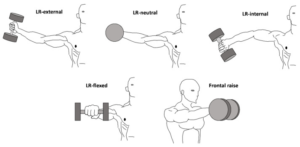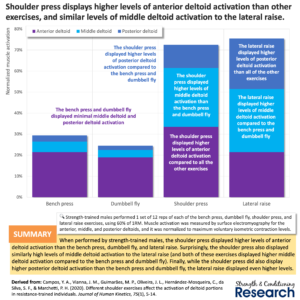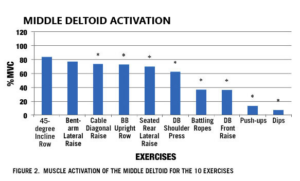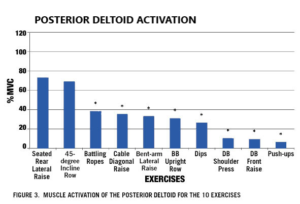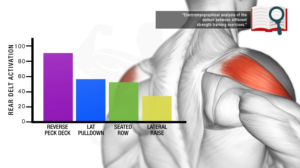LATERAL RAISE
Click on Image to Enlarge
EMG STUDIES
ANTERIOR-LATERAL-POSTERIOR DELTOID, UPPER TRAPEZIUS
– DB Lateral Raise 4 Variations
Analysis of Lateral Raise Variations and Frontal Raise in Competitive Bodybuilders – 2020 – Coratella
Procedure
– Concentric and Eccentric phase; 10 competitive bodybuilders
(1) Lateral Raise Straight Arm External Rotation or Thumbs Up or Full Can
(2) Lateral Raise Straight Arm Thumbs Neutral
(3) Lateral Raise Straight Arm Internal Rotation or Thumbs Down or Empty Can
(4) Lateral Raise Bent arm @90º
Concentric Range Results for the Lateral Raise
Anterior or Front Deltoid:
– straight arm thumbs up 75% . flexed elbow 65% . straight arm thumbs neutral 35% . straight arm thumbs down 35%
Lateral or Side Deltoid:
– straight arm thumbs neutral 55% . straight arm thumbs down 55% . straight arm thumbs up 50% . flexed elbows 35%
Posterior or Rear Deltoid:
– straight arm thumbs down 85% . straight arm thumbs neutral 55% . flexed elbow 55% . straight arm thumbs up 35%
Upper Trapezius:
– straight arm thumbs down 40% . flexed elbows 35% . straight arm thumbs neutral 30% . straight arm thumbs up 30%
SUPRASPINATUS, LATERAL & POSTERIOR DELTOID
– DB Scapular Plane Raise 3 Variations
EMG of the Supraspinatus and Deltoid Muscles During 3 Common Rehabilitation Exercises – 2007 – Reinold
Procedure
– To quantify EMG activity of the supraspinatus, middle deltoid, and posterior deltoid muscles; 22 asymptomatic subjects (15 men, 7 women) with no history of shoulder injury
– MVIC and 5 repetitions of 3 exercises:
(1) Scapular Plane Raise – straight arm external rotation or thumbs up or full can
(2) Scapular Plane Raise – straight arm with glenohumeral internal rotation “empty can”
(3) Prone horizontal abduction @100° with glenohumeral external rotation “prone full can”.
Results
Supraspinatus: No statistical difference existed among the exercises for the supraspinatus
Middle Deltoid: empty-can 77 ± 44% . prone full-can 63 ± 31% . full-can 52 ± 27%
Posterior Deltoid: prone full-can 87 ± 53% . empty-can 54 ± 24% . full-can 38 ± 32%
ANTERIOR-LATERAL-POSTERIOR DELTOID
– DB Lateral Raise vs. Overhead Press
Different Shoulder Exercises Affect the Activation of Deltoid Portions in Resistance-Trained Individuals – 2020 – Campos
Procedure
– 13 men experienced in strength training; maximum isometric voluntary contraction (MVIC); one set of 12 repetitions with the load of 60% 1RM
Exercises
(1) bench press: 165% bi-acromial distance; elbows extended; lowered bb until shoulders reached a horizontal abduction of approx 45º below the trunk line
(2) dumbbell fly: lowered db until shoulders reached a horizontal abduction of approx 45º below the trunk line
(3) shoulder press overhead – seated back to upright bench: 135º shoulder adduction
(4) lateral raise – thumbs up – seated back to upright bench: perform 90º of shoulder abduction from the anatomical position
Results
Anterior or Front Deltoid: shoulder press 35% . lateral raise thumbs up 20% . bench press 20% . db flye 20%
Lateral or Middle Deltoid: lateral raise thumbs up 30% . shoulder press 30%
Posterior or Rear Deltoid: lateral raise thumbs up 25% . shoulder press 10%
ANTERIOR-LATERAL-POSTERIOR DELTOID
– DB Lateral Raise, Cable Lateral Raise, Reverse Fly, Incline Row elbows out, DB Overhead Press
ACE Research – Top Shoulder Exercises – 2015 – Sweeney – PDF Thesis .
Procedure
– all of the subjects were required to have some weight-lifting experience and attended one mandatory practice session
Exercises
1. DB Overhead Press
2. Bent Arm DB Lateral Raise thumbs neutral 3. Straight Arm Cable Lateral Raise
4. Seated Rear Lateral Raise – Reverse Fly . 5. 45º Incline Row elbows out
Results
Anterior Deltoid: DB OHP 75% .
Lateral Deltoid: 45º Incline Row elbows out 85% . DB Lateral Raise 80% . Cable Lateral Raise 75% . Seated Rev Fly 70% . DB OHP 60%
Posterior Deltoid: Seated Reverse Fly 75% . 45º Incline Row elbows out 70%
ANTERIOR, MIDDLE & POSTERIOR DELTOID
– Lateral Raises, Reverse Pec Deck, Incline Lat Pulldown, Seated Machine Row
– Shoulder Press, Bench Press, Pec Deck
EMG of the Deltoid Between Different Strength Training Exercises – 2013 – Botton, Wilhelm, Pinto, Ugjni, Lima
Subjects
– at least six months strength training
Exercises
1. Smith Machine Shoulder Press; Bench Press; Pec Deck
2/3. DB and Cable Crossover Lateral Raises
4. Seated Row elbows up – seated upright; pronated grip; shoulders abducted to 90°; horizontal shoulder extension
5. Reverse Pec Deck – neutral grip and elbows straight, performing horizontal shoulder extension
6. Incline Lat Pull elbows up – posterior tilt position so that the cable of the machine was perpendicular to the body.
Results
Anterior Deltoid: Smith Shoulder Press 70% . Bench Press 55% . Pec Deck 50%
Lateral Deltoid: DB Lateral Raise 55% . Cable Lateral Raise 55% . Reverse Pec Deck 50% . Seated Row 40% . Smith Shoulder Press 25%
Posterior Deltoid: Reverse Pec Deck 90% · Inclined Lat Pulldown 55% · Seated Row 50% . DB Lateral Raises 35% . Cable Lateral Raise 35%
EKSTROM, DONATELLI, SODERBERG STUDY – TRAPEZIUS, SERRATUS ANTERIOR
UPPER TRAPEZIUS
– Unilateral Shoulder Shrug, DB Lateral Raise, Prone “Y”, DB Low to High, Prone “T”, DB Row
Surface EMG of exercises for the trapezius and serratus anterior – 2003 – Ekstrom
Results MVIC
Upper Trapezius: was activated maximally with exercises requiring a great amount of upward rotation of the scapula
120% – Unilateral Shoulder Shrug
79% – Shoulder Ab-duction in the plane of the scapula >120º: DB thumbs up raise in the plane of the scapula finishing above 120º
79% – Prone Arm Raise Overhead: in line with the lower fibers of the lower trapezius
72% – Shoulder Ab-duction in the plane of the scapula <80º: DB thumbs up raise in the plane of the scapula finishing below 80º
66% – Diagonal Low to High: DB shoulder flexion + horizontal flexion + external rotation
66% – Prone Shoulder Horizontal Extension with External Rotation
63% – Prone Unilateral Row: face-down on a bench
– For Serratus Anterior results see → Serratus Anterior – Overhead Exercises .
MIDDLE TRAPEZIUS
– Prone “Y”, Prone “T”, DB Row
Surface EMG of exercises for the trapezius and serratus anterior – 2003 – Ekstrom
Results MVIC
Middle Trapezius
101% – Prone Arm Raise Overhead: in line with the lower fibers of the lower trapezius
87% – Prone Shoulder Horizontal Extension with External Rotation
79% – Prone Unilateral Row: face-down on a bench
53% – Unilateral Shoulder Shrug
49% – Shoulder Ab-duction in the plane of the scapula >120º: DB thumbs up raise in the plane of the scapula finishing above 120º
47% – Shoulder Ab-duction in the plane of the scapula <80º: DB thumbs up raise in the plane of the scapula finishing below 80º
45% – Prone Shoulder external rotation with the shoulder abducted 90° and the elbow flexed 90°: elbow supported on the table.
LOWER TRAPEZIUS
– Prone “Y”, Prone “T”, Prone “W”, DB Lateral Raise
Surface EMG of exercises for the trapezius and serratus anterior – 2003 – Ekstrom
Results MVIC
Lower Trapezius
97% – Prone Arm Raise Overhead “Y”: in line with the lower fibers of the lower trapezius
79% – Prone Shoulder external rotation with shoulder abducted 90° and elbow flexed 90°: elbow supported on table
74% – Prone Shoulder Horizontal Extension with External Rotation “T”
61% – Shoulder Ab-duction in the plane of the scapula >120º: DB thumbs up raise in the plane of the scapula finishing above 120º
50% – Shoulder Ab-duction in the plane of the scapula <80º: DB thumbs up raise in the plane of the scapula finishing below 80º
45% – Prone Unilateral Row: face-down on a bench
39% – Diagonal Low to High: DB shoulder flexion + horizontal flexion + external rotation
SERRATUS ANTERIOR
– DB Low to High, DB Lateral Raise, BB or DB Flat Bench Plus,
Surface electromyographic analysis of exercises for the trapezius and serratus anterior muscles – 2003 – Ekstrom
Results
Serratus Anterior: was activated maximally with exercises requiring a great amount of upward rotation of the scapula
100 – DB shoulder flexion + horizontal flexion + external rotation
96 – Shoulder Ab-duction in the plane of the scapula >120º; DB thumbs up raise in the plane of the scapula finishing above 120º
62 – DB thumbs up raise in the plane of the scapula finishing below 80º
62 – DB Flat Bench Plus or BB Flat Bench Plus (with weight on one side of bar) finishing with Plus push at top
57 – Shoulder external rotation with shoulder abducted 90° and elbow flexed 90° in prone position with elbow supported on table
53 – Bilateral scapular protraction with shoulder horizontally flexed to 45° and elbows flexed to 45° in supine position.
.



